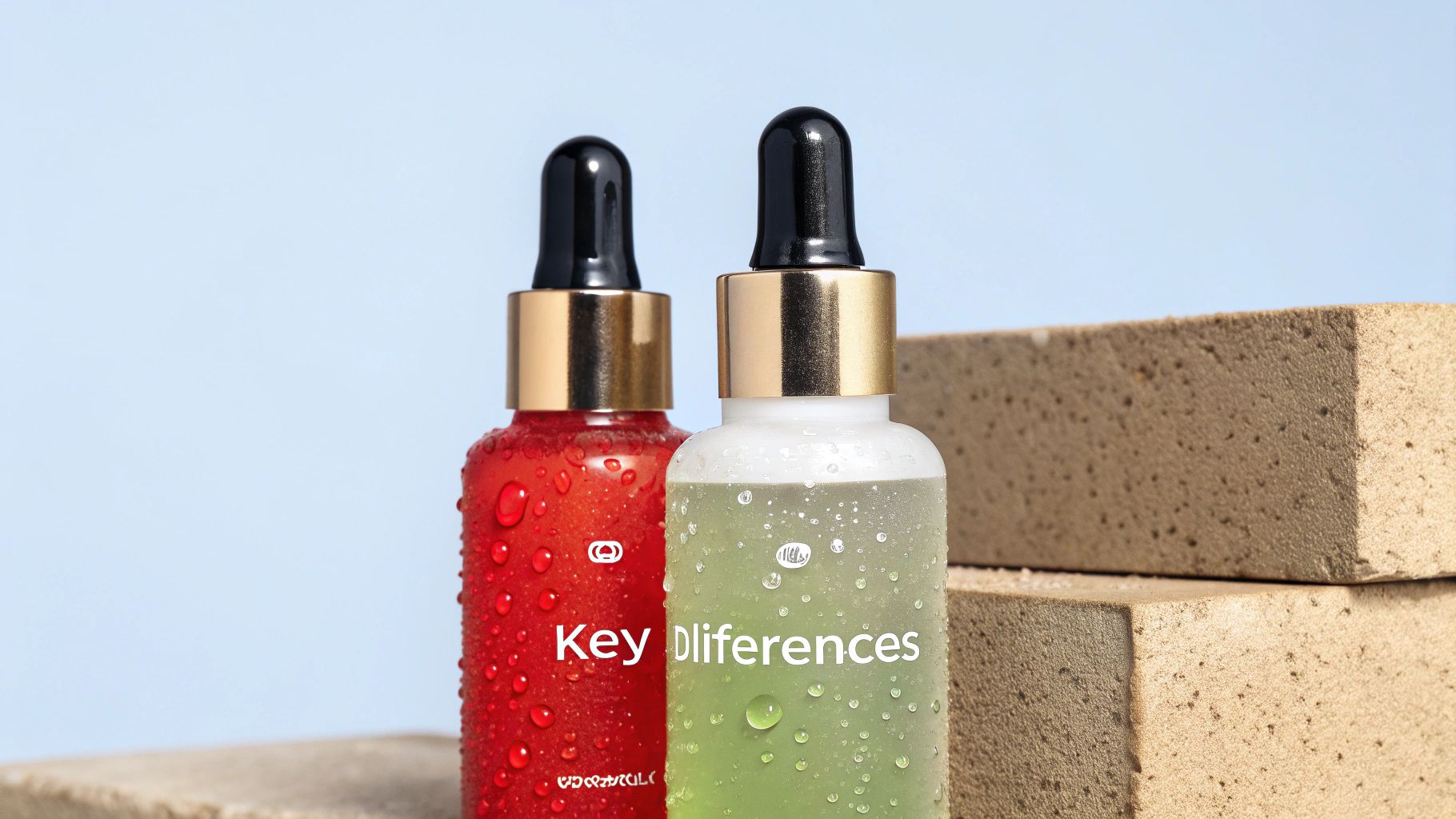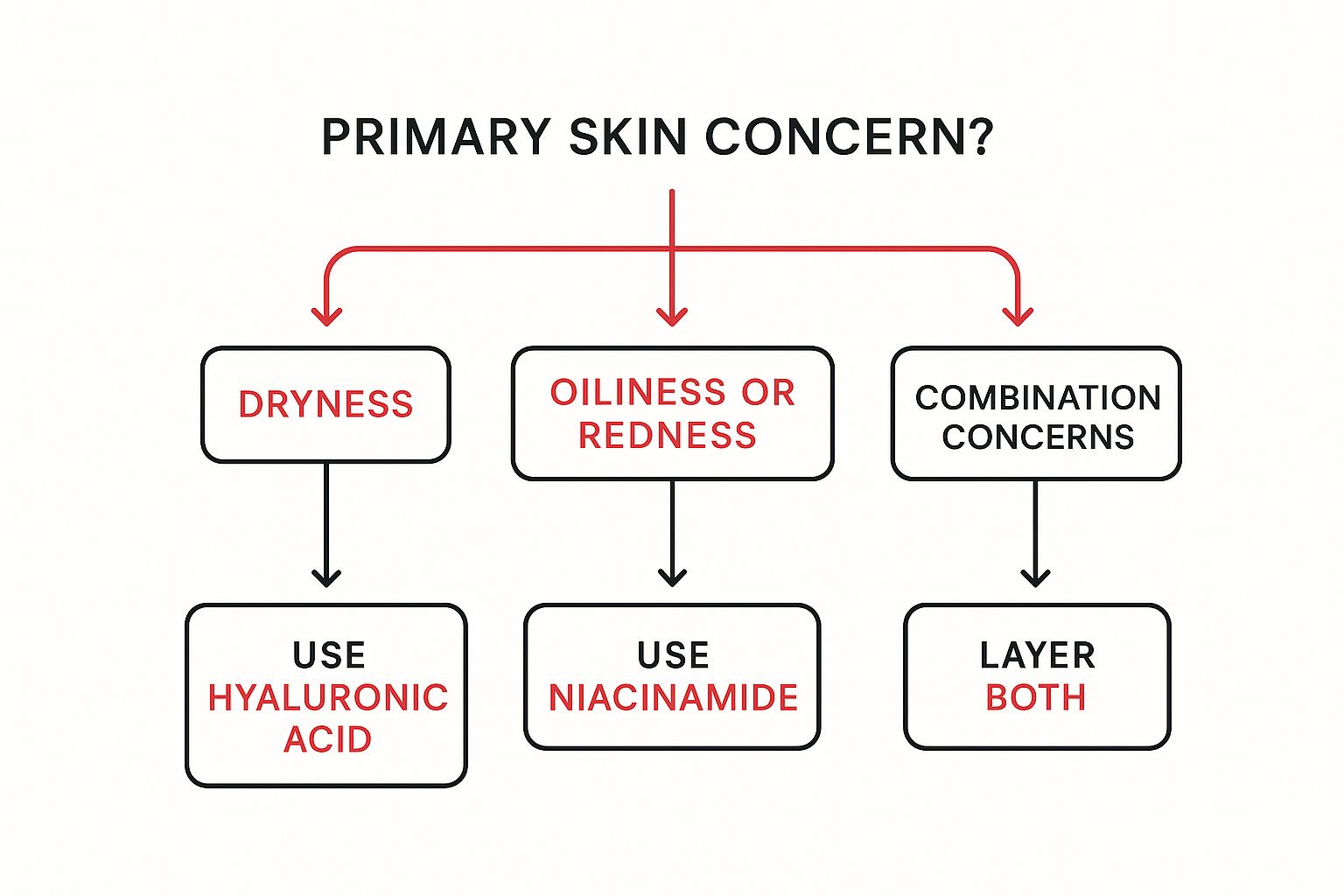
Hyaluronic Acid vs Niacinamide: Which Is Better for Your Skin?
Share
Understanding The Science Behind These 2 Skincare Powerhouses
This screenshot from Wikipedia illustrates the molecular structure of hyaluronic acid (HA), revealing its repeating disaccharide units. These units are the key to HA’s remarkable ability to bind water.

This complex structure allows a single HA molecule to hold an astounding 1000 times its weight in water, which explains its powerful hydrating effects. This makes it incredibly effective at combating dryness and improving skin elasticity. This rise in popularity is mirrored in market trends. The UK market for hyaluronic acid in personal care, for example, is experiencing a surge, with projected revenues expected to reach USD 296.0 million by 2030, growing at a CAGR of 7.4%. Learn more about the hyaluronic acid market. However, just applying HA doesn't guarantee results. Its efficacy is influenced by factors like molecular weight.
This is where understanding the contrast between hyaluronic acid and niacinamide becomes vital. While HA focuses on attracting and retaining water, niacinamide, a form of vitamin B3, works through different pathways. Niacinamide fortifies the skin's protective barrier, minimizing transepidermal water loss and bolstering its resilience against environmental aggressors. Its anti-inflammatory properties also help soothe irritated skin and address concerns like redness and blemishes.
Absorption and Penetration: Key Differences
The absorption pathways of these two ingredients also diverge. Hyaluronic acid, particularly larger molecular weight versions, primarily hydrates the outermost layers of the skin. Smaller molecular weight versions can penetrate deeper, but this penetration is still limited when compared to niacinamide.
Niacinamide, a smaller molecule, penetrates the skin more easily, influencing cellular activity and affecting sebum production, pigmentation, and inflammation. This deeper reach enables it to target a broader range of skin issues beyond surface hydration. For example, it can minimize the appearance of pores, even out skin tone, and reduce breakouts.
The Synergistic Power of the Duo
This distinct functionality of hyaluronic acid and niacinamide explains why they work so well in tandem. Their combined use creates a synergistic effect: HA hydrates the outer layers while niacinamide strengthens and improves skin health from within.
Understanding this interaction is crucial for building an effective skincare routine tailored to your specific needs.
When Your Skin Desperately Needs Hyaluronic Acid

Hyaluronic acid (HA) is known for its hydrating properties. But beyond the simple claim of “hydration,” there are specific situations where HA truly excels. Think of the drying effects of prolonged air conditioning exposure. This constant artificial climate leaches moisture from the skin, leaving it feeling parched and vulnerable. Hyaluronic acid acts like a sponge, drawing moisture back into the skin and replenishing its hydration reserves.
Similarly, climate-induced moisture loss, whether from harsh winters or scorching summers, highlights the importance of HA. These environmental extremes can damage the skin’s natural barrier function, increasing water loss and reducing the skin's ability to retain moisture. HA provides crucial support, helping maintain a healthy, hydrated skin barrier. For more on this, explore how to treat dehydrated skin.
Recognizing When Your Skin is Crying Out for HA
So, how can you tell if your skin is craving hyaluronic acid? Telltale signs include tightness, flakiness, and a dull appearance. These indicate depleted moisture levels and a compromised skin barrier. Increased sensitivity is another clue. Dehydrated skin becomes more prone to irritation and inflammation, reacting poorly to products that normally wouldn't cause issues.
The effectiveness of HA also depends on individual factors like skin thickness and oil production. Those with thinner or naturally dry skin often see more dramatic results with HA because it directly addresses their inherent lack of moisture. Those with thicker or oilier skin might not experience as noticeable a change. Your current skincare routine also matters. Using products that strip the skin’s natural oils can worsen dryness and amplify the need for HA.
Individualized Responses to Hyaluronic Acid
Why the varied responses to hyaluronic acid? Some people experience significant improvement, while others see little change. Several factors contribute to this. The molecular weight of the HA is key. Lower molecular weight HA penetrates deeper, delivering hydration to underlying layers, while higher molecular weight HA focuses on surface hydration. This difference in penetration affects the visible results. Skin type also plays a role, with oily skin typically requiring less HA than dry skin.
Let's look at how HA performs across different skin conditions:
To help visualize the effectiveness of hyaluronic acid on various skin conditions, consult the table below:
Hyaluronic Acid Performance by Skin Condition
| Skin Condition | Effectiveness Rating | Best Application Method | Expected Timeline |
|---|---|---|---|
| Dryness/Dehydration | High | Serum or moisturizer applied to damp skin | Immediate and ongoing |
| Dullness | Medium | Serum or mask | 1-2 weeks |
| Fine lines/Wrinkles | Medium | Serum with peptides or retinol | 4-6 weeks |
| Redness/Irritation | Low-Medium | Gentle serum or moisturizer | Varies depending on the cause |
| Oily/Acne-prone | Low | Lightweight serum or gel | May not be necessary for all individuals |
This table offers a general guideline. Individual results can vary depending on the specific HA product used and other factors discussed earlier. Remember to patch test any new product to ensure compatibility with your skin.
Niacinamide's Multi-Tasking Reality Check

While hyaluronic acid is a champion hydrator, niacinamide, a form of vitamin B3, often receives acclaim as a skincare multi-tasker. Its purported benefits span a wide range, from inflammation and redness reduction to oil control and pore minimization. However, the reality of its efficacy is more nuanced than marketing might suggest. This exploration delves into where niacinamide truly shines and where its benefits might be overstated. You might be interested in: LULUMINE's Niacinamide Gel Moisturiser.
Deciphering the Hype: Where Niacinamide Excels
Niacinamide's strongest suit lies in its anti-inflammatory properties. For those dealing with redness, rosacea, or acne-prone skin, it can offer significant relief. Niacinamide works by soothing irritated skin and reducing the production of inflammatory cytokines, the messengers that trigger inflammation. This leads to a visible decrease in redness and blemishes.
Furthermore, niacinamide shows promise in improving skin barrier function. A stronger barrier translates to less transepidermal water loss, resulting in better hydration and resilience against environmental stressors. This makes it a good option for those in harsher climates, offering protection against both winter dryness and summer sun damage.
The Concentration Conundrum: Why Percentage Matters
The concentration of niacinamide plays a vital role in its effectiveness. While many brands avoid disclosing specific percentages, this information is critical. A 2-5% concentration is generally effective for most, while higher concentrations, such as 10%, may benefit those with stubborn hyperpigmentation or acne. Too low a concentration can yield disappointing results, while too high a concentration can cause irritation, especially for sensitive skin.
Addressing Irritation: Why Some React Negatively
While generally well-tolerated, niacinamide can cause irritation, redness, or even breakouts in some individuals. This often occurs when starting with a concentration that's too high. Beginning with a lower concentration and gradually increasing as your skin adapts is recommended. Patch testing is vital, particularly for sensitive skin, to preemptively identify potential reactions.
Interestingly, hyaluronic acid's utility extends beyond skincare into medical and pharmaceutical applications. The UK's hyaluronic acid market is projected to hit £486 million by 2035, with a CAGR of 14.65%. Discover more insights about the hyaluronic acid market. This highlights its diverse value across multiple sectors.
This broader context emphasizes the importance of understanding ingredient selection within a specific skincare routine. Niacinamide offers substantial benefits when used correctly, but a careful, informed approach is essential to maximizing its potential and minimizing any adverse reactions.
Why Most Products Fail Despite Good Ingredients
The image below, taken from Wikipedia, shows the chemical structure of niacinamide, highlighting its amide group. This structural feature plays a key role in how niacinamide interacts with the skin.
The presence of both nitrogen and oxygen in this specific arrangement contributes to niacinamide's anti-inflammatory and barrier-strengthening effects. However, even the best ingredients can underperform in a poorly designed product. Let’s explore why.
When choosing between hyaluronic acid and niacinamide, the product formulation itself often determines its effectiveness. Even top brands sometimes miss crucial formulation details. Consider hyaluronic acid: its molecular weight significantly impacts its ability to penetrate the skin.
Larger hyaluronic acid molecules hydrate the surface, while smaller ones go deeper. Many products use just one molecular size, limiting their hydrating power.
Niacinamide's effectiveness is also highly dependent on pH. The wrong pH can neutralize niacinamide, making it essentially inactive despite being listed as an ingredient. This is a common problem in less expensive products, explaining why some budget options fail to impress.
Unmasking Formulation Shortcuts
Experienced cosmetic chemists see how manufacturing shortcuts often compromise promising ingredients. One frequent issue is excessive fillers and thickeners. These dilute active ingredients and hinder their performance, much like watering down a strong medicine.
Packaging is another important element. Light and air exposure can degrade active ingredients such as niacinamide. Opaque, airtight containers are vital for preserving product stability. However, many brands choose less protective packaging to cut costs. This often leads to reduced product performance over time.
Spotting Inferior Products
There are several signs of a subpar formulation. Texture inconsistencies, like clumping or separation, suggest instability. A strong, artificial fragrance can mask the smell of low-quality ingredients. Over-the-top marketing claims focused on trendy buzzwords instead of scientific evidence should also be a red flag.
Understanding these formulation details helps explain why some less expensive products can sometimes outperform pricier ones. A well-formulated product prioritizes quality ingredients, the right pH, and suitable packaging, even at a lower price. By looking beyond marketing hype and evaluating product quality effectively, you can make smarter decisions and invest in products that deliver real results.
To illustrate this further, let's take a look at some key formulation factors.
Understanding these nuances is essential for choosing effective skincare products. The table below summarizes key differences in formulation requirements for hyaluronic acid and niacinamide.
Key Formulation Factors Comparison
| Formulation Factor | Hyaluronic Acid Requirements | Niacinamide Requirements | Impact on Results |
|---|---|---|---|
| Molecular Weight | Varied molecular weights for optimal hydration | Not applicable | Multi-layered hydration vs. surface-level only |
| pH | Less sensitive | Specific pH range essential | Maintains efficacy vs. neutralized ingredient |
| Packaging | Airtight to prevent evaporation | Opaque and airtight to prevent oxidation | Preserves potency vs. degradation |
| Preservatives | Necessary to prevent microbial growth | Compatible preservatives required | Stable product vs. contamination |
As this table demonstrates, seemingly minor formulation choices can have a significant impact on the final product's efficacy. Both hyaluronic acid and niacinamide require careful consideration during the formulation process to ensure their beneficial properties are maximized.
Strategic Decision Making: Which Ingredient Fits Your Life
Choosing between hyaluronic acid and niacinamide isn't about picking a "winner." It's about understanding which ingredient best suits your skin's unique needs and your lifestyle. The infographic below illustrates how your primary skin concern can guide your ingredient choice, leading you to hyaluronic acid for dryness, niacinamide for oiliness/redness, or a combination of both for more complex concerns.

As the infographic shows, focusing on your main skin issue yields the best results. Consider a busy professional frequently exposed to dry office air conditioning. They might find niacinamide’s stability and ease of application more practical than hyaluronic acid, which can be more dependent on environmental humidity. Niacinamide's multi-tasking benefits also simplify a busy routine. Someone in a harsher climate, like the UK’s windswept coastal regions, might prioritize hyaluronic acid’s intense hydration to protect against dryness and bolster their skin barrier. This emphasizes the importance of context in ingredient selection.
Practical Considerations: Timing, Layering, and Seasonal Shifts
Application timing and layering can also influence your choice. Niacinamide generally integrates easily into most routines, playing well under makeup and with other active ingredients. Hyaluronic acid can sometimes pill or feel sticky if not layered properly. Applying it to damp skin before moisturizer maximizes absorption and avoids any residue.
Seasonal changes also call for adjustments. During winter, layering hyaluronic acid under a richer moisturizer combats dryness. In summer, a lighter hyaluronic acid serum may be sufficient, especially for oily or combination skin. Niacinamide, with its consistent performance, often becomes a year-round staple, providing steady support regardless of the weather.
Honest Expectations and Common Mistakes
Realistic expectations are essential. Neither ingredient offers overnight miracles. Consistency is key for visible, long-term improvement. A common mistake is using too many products at once, which can irritate skin instead of helping it. For tips on creating a natural glow, check out our guide on mindful beauty routines. Start with a simple, well-formulated routine and introduce one new ingredient at a time to assess its impact and fine-tune your strategy.
Adapting Your Strategy to Life Changes
Life changes affect your skin. Stress, hormonal shifts, and travel can disrupt its balance. Recognizing when your routine needs tweaking is crucial. Perhaps your once-balanced skin now feels constantly dry, suggesting a need for more hyaluronic acid. Or maybe stress has triggered breakouts, hinting that niacinamide could help. Regularly assessing your skin and adjusting your routine helps you maintain healthy, radiant skin through life’s transitions.
Navigating UK Market Reality: What Actually Delivers
The UK skincare market overflows with hyaluronic acid and niacinamide products. However, finding consistently high-quality formulations can be tricky. Distinguishing truly effective products from cleverly marketed ones requires careful consideration of how brands prioritize efficacy over hype. This means understanding ingredient sourcing, manufacturing processes, and, crucially, actual performance data.
Identifying Genuine Innovation
Many brands boast “innovative” formulas, yet frequently simply repackage existing trends. True innovation stems from a deep understanding of each ingredient's nuances. For instance, a brand utilizing different molecular weights of hyaluronic acid demonstrates a more sophisticated approach to hydration than one using a single, standard form. Likewise, disclosing the specific niacinamide percentage reflects a commitment to transparency, empowering consumers to select the concentration best suited to their individual skin needs. Look for brands that emphasize these details rather than relying on vague marketing language.
A brand committed to quality will showcase this through transparency. They will clearly highlight their sourcing practices. Ideally, they would openly share the percentage of ingredients like niacinamide. Multiple molecular weights of HA will allow consumers to benefit from a wider range of absorption rates.
Sourcing and Stability: Import Considerations
The origin of ingredients directly impacts product quality. Hyaluronic acid sourced from reputable suppliers ensures purity and maximized effectiveness. For UK consumers, understanding import regulations is vital. Fluctuations in temperature and humidity during transport can compromise ingredient stability, particularly for moisture-sensitive ingredients like hyaluronic acid. Prioritize brands with robust supply chains and stringent quality control measures to guarantee product potency.
Consider a brand's supply chain and its quality control measures. Fluctuations in temperature and humidity during the often long and sometimes unpredictable import routes can affect ingredient stability. This is especially important when dealing with moisture-sensitive ingredients like hyaluronic acid.
Finding Value Across Price Points
Effective skincare isn't always synonymous with a hefty price tag. Surprisingly, some high-street brands offer well-formulated hyaluronic acid and niacinamide products that rival their more expensive counterparts. Conversely, some luxury brands may prioritize elaborate packaging and marketing over formula efficacy. By carefully analyzing ingredient lists, scrutinizing manufacturing standards, and considering user reviews, you can discover truly valuable products across a range of price points.
Don't assume that a higher price tag guarantees better quality. Some budget-friendly brands offer remarkably well-formulated products while some premium brands invest more heavily in packaging and marketing. Thoroughly examining the ingredients, manufacturing information, and user reviews can help you discover valuable products regardless of their price.
Realistic Budgets and Reliable Sources
Building an effective skincare routine incorporating hyaluronic acid and niacinamide requires a realistic budget. Fortunately, many affordable options deliver excellent results. Seek out brands that prioritize ingredient quality and effective formulations over flashy marketing. Independent online resources and beauty blogs frequently provide invaluable reviews and comparisons, enabling you to identify reliable sources of quality ingredients within a reasonable budget. These resources are indispensable tools for navigating the complexities of the UK market and making informed choices for your skincare routine.
Building an effective skincare routine doesn't necessitate breaking the bank. Plenty of affordable brands deliver real results. When choosing a brand, focus on the quality of its ingredients and formulation instead of marketing campaigns. Independent reviews and comparisons from beauty blogs or online skincare communities can provide great insights when making your final decision.
Your Decision Framework: From Analysis to Action
Understanding the distinct properties of both hyaluronic acid and niacinamide empowers you to make informed skincare decisions. This framework helps navigate the decision-making process, considering your unique skin concerns, daily routine, budget, and long-term goals. Through practical assessment and honest self-reflection, you’ll discover whether your skin needs hydration support, multi-functional treatment, or a combined approach.
Identifying Your Primary Skin Concern
First, pinpoint your main skin issue. Is dryness and dehydration your primary concern? Or do you struggle with oiliness, redness, or breakouts? Perhaps you experience a combination of issues, such as dryness in some areas and oiliness in others.
Clearly defining your primary concern helps narrow your ingredient focus. For example, if persistent dryness plagues you, hyaluronic acid's hydrating properties are a clear front-runner.
Lifestyle Integration and Routine Compatibility
Next, consider how each ingredient fits into your existing routine and lifestyle. Are you a busy professional with limited time for elaborate skincare rituals? Niacinamide’s stability and ease of application might be preferable to hyaluronic acid, which may require more attention to layering and humidity.
If your lifestyle involves frequent travel or exposure to varying climates, niacinamide's consistent performance across different conditions is a valuable asset.
Budgetary Considerations and Product Selection
Budget always plays a role in ingredient selection. While some premium hyaluronic acid serums come with higher price tags, effective, affordable options are available. Similarly, you can find excellent niacinamide products at various price points. Researching reviews and comparing ingredient lists helps you identify value across different budgets, allowing you to prioritize efficacy without overspending.
Remember, a higher price tag doesn’t automatically equate to superior quality.
Realistic Timelines and Troubleshooting
Set realistic expectations. Neither hyaluronic acid nor niacinamide offers instant transformations. Consistency is the key to visible, lasting results. Be patient and allow your skin time to adjust.
If you encounter unexpected reactions like irritation or breakouts, reassess your routine. Perhaps the niacinamide concentration is too high for your skin, or the hyaluronic acid isn't layered correctly. Troubleshooting common issues ensures you maximize each ingredient's benefits.
Adaptability and Ongoing Assessment
Finally, remember that your skin's needs evolve. Stress, hormonal fluctuations, seasonal changes, and lifestyle adjustments can all influence your skin’s condition. Regularly assess your skin and adapt your routine accordingly.
Perhaps your once-oily skin now feels dry, signaling a need for hyaluronic acid. Or increased stress might trigger breakouts, suggesting niacinamide’s calming properties. Ongoing assessment ensures your skincare strategy remains aligned with your skin’s changing needs.
LULUMINE’s Targeted Solutions: Hyaluronic Acid & Niacinamide Essentials
- Hydrating Serum: A lightweight, fast-absorbing serum that floods skin with multi-molecular hyaluronic acid for plump, dewy radiance.
- Oil-Free Hydrating Gel: Perfect for oily or combination skin, this gel delivers intense hydration without heaviness.
- Double Hydration Boost Gel: For those who crave extra moisture, this gel combines hyaluronic acid with soothing botanicals for a long-lasting hydration surge.
- Ceramide Hydrating Night Cream: Lock in moisture overnight and wake up to soft, replenished skin.
- Niacinamide Gel Moisturiser: Strengthens the skin barrier, refines pores, and balances oil while delivering lightweight hydration.
- Pigment Perfecting Serum: Combines niacinamide with brightening actives to target dark spots and uneven skin tone for a luminous complexion.
- Botox-Like Peptide Serum: Smooths and firms skin while supporting barrier health with niacinamide and advanced peptides.
- Hydrating Toner: Start your routine with this gentle, alcohol-free toner to boost hydration and prep your skin for maximum serum absorption.
Layering hyaluronic acid and niacinamide is a powerhouse combo—apply your hydrating serum first, then follow with a niacinamide-based moisturizer or serum for optimal results.
Explore our full LULUMINE skincare collection to build a routine that’s as unique as your skin.
